Heritage Leather's on Motorcycle Culture
Posted by HASSAN KHAN

The Enduring Legacy:
Leather and motorcycles, an inseparable duo, evoke images of freedom, rebellion, and raw masculinity. But the connection runs deeper than mere aesthetics; it's a rich tapestry woven with history, tradition, and cultural significance. Let's delve into the heritage of leather in motorcycling, tracing its roots and exploring its profound impact on rider culture.
The Roots of Leather in Motorcycling:
From its humble beginnings, leather has been the go-to material for motorcycle gear, owing much to its durability and protective properties. Early riders, navigating treacherous roads on primitive machines, relied on leather to shield themselves from the elements and potential hazards.
Leather in Popular Culture:
Transitioning into the mid-20th century, as motorcycling surged in popularity, leather became synonymous with the burgeoning subculture. Films like "The Wild One," featuring Marlon Brando clad in a leather jacket astride his Triumph, cemented the iconic image of the rebel biker.
Camaraderie and Community:
Yet, while leather exuded an aura of defiance and nonconformity, it also symbolized a sense of camaraderie among riders. Bikers formed tight-knit communities, united by their love for the open road and the distinctive attire that bound them together.
Leather Beyond the Road:
Despite its association with rebellion, leather also found its place in mainstream fashion, transcending its origins in motorcycling. High-end fashion houses embraced the rugged allure of leather, elevating it to a symbol of luxury and sophistication.

Evolution and heritage:
However, as motorcycle culture evolved, so too did the perception of leather within the community. While some purists insist on the timeless appeal of classic leather jackets and chaps, others have embraced modern materials offering enhanced safety and comfort.
The Enduring Allure:
Yet, even amidst technological advancements, leather retains its allure, serving as a link to motorcycling's storied past. It embodies the spirit of the road, carrying with it tales of adventure, triumph, and camaraderie.
Craftsmanship and Tradition:
Moreover, the craftsmanship inherent in leather goods speaks to a bygone era, where quality was paramount and each piece told a story of its own. Riders, drawn to the authenticity and heritage of leather, continue to cherish their prized possessions, passing them down through generations.
Resurgence and Recognition:
In recent years, there has been a resurgence of interest in vintage motorcycles and the accompanying lifestyle, reigniting appreciation for leather's role in shaping rider culture. Events like vintage bike rallies and custom leather workshops celebrate this enduring legacy, paying homage to the craftsmanship and tradition of yesteryear.
Leather's Heritage:
However, amidst the nostalgia, there's a growing awareness of the ethical and environmental implications of leather production. With sustainability at the forefront of consumer consciousness, riders are exploring alternative materials that offer both performance and eco-friendliness.
Nevertheless, for many enthusiasts, leather remains an indispensable part of the motorcycling experience, embodying the thrill of the open road and the sense of camaraderie forged among riders. Whether cruising down the highway or gathering at a local biker hangout, leather serves as a tangible reminder of the timeless allure of motorcycle culture.
Conclusion
Leather's role in motorcycling is rich with tradition, rebellion, and camaraderie. It began as a necessity, evolved into a cultural icon, embodying freedom and adventure. For enthusiasts, leather is integral to the riding experience, symbolizing the thrill of the road and the bonds between riders. As we move forward, leather will continue to represent the timeless allure of motorcycle culture.



